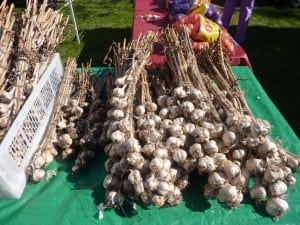By Pamela Doan
Hungarian Purple, Marino, German White, Killarney, Oregon Blue, Musik, Spanish Roja, Nirvana Weird, Rose Du Var, Belarus – these are some of the dozens of different types of garlic that could be found at the Hudson Valley Garlic Festival Sept. 28-29 in Saugerties.
Unless you’ve been to a garlic festival, you might not know that so many varieties exist. Grocery stores usually have only one selection, an indeterminate mid-size bulb with cloves that give off a uniform flavor. When using garlic in cooking, there can be subtle shifts to flavor by using a specific type, though. Garlic can be spicy, nutty, zesty, hot, sharp, buttery, mild, potent and sweet. Depending on which type you use, it will contribute those characteristics to the dish.
At the Garlic Festival, all of the garlic is available for sampling. Life takes on a sharper, more fragrant focus when you’ve sampled multiple cloves over the course of a day, I can say, but how else can you know what you like? October is the time to plant garlic for harvest the following July. It’s a cold-hardy root vegetable and will go dormant during the winter and start growing in the spring. Just get it in the garden before the ground freezes and next summer you can enjoy scapes, the stalk of the plant that grows above ground, and big, juicy bulbs.
Garlic festivals and farmers’ markets offer a good chance to sample and buy bulbs for planting and it can also be ordered online from nurseries at this time of year. Hardneck garlic forms scapes; softneck does not, but most types mature faster. The garlic found in most grocery stores is softneck because it travels well and stores longer. Hardneck can be hardier, though, and grows well here.
 To plant garlic, separate the individual cloves from the bulb. I like to pick out large, plump cloves, but any size should work. The head of the clove, the pointed end, should point up when you put it in the ground. Plant it about two inches deep in a sunny spot that has well-drained soil.
To plant garlic, separate the individual cloves from the bulb. I like to pick out large, plump cloves, but any size should work. The head of the clove, the pointed end, should point up when you put it in the ground. Plant it about two inches deep in a sunny spot that has well-drained soil.
The optimal pH for garlic is between 6.5-7, which is the same fertility range for most of the vegetables typically grown in home gardens. Adding a layer of straw mulch will keep it warm and protect the garlic from being moved around when the ground heaves and thaws throughout the winter. When shoots appear in the spring, move the mulch away so the garlic can get plenty of sunlight.
I’ve read and been told to plant garlic anywhere from 1 inch to 6 inches apart. Last year I followed the 6-inch spacing rule, but after talking to an organic farmer from Vermont who spaces his plants 1 inch apart and seeing photos of his fields, I’m going to try a tightly spaced section this fall and see what happens.
One farmer I spoke with shared his method for maximizing soil fertility. Gale Sheradin of Grandpa’s Garlic, a farm in the Catskills, said, “As soon as we harvest the garlic in July, we plant buckwheat. It’s one of the few plants that will grow to maturity quickly and by September, it’s already flowered and matured. We cut it off and work it into the soil to prepare the fields to be planted again in October.” Buckwheat works as a soil enhancer. Sheradin continued: “It adds nutrients, particularly magnesium, and helps break down the nutrients in the soil so the garlic can use them better.”
Sheradin’s buckwheat is a cover crop and serves many purposes in addition to adding nutrients. Since a bare field would have nothing to keep the soil in place and would invite weeds, the cover crop keeps the weeds down between plantings and also prevents erosion. Cover crops like winter rye and winter wheat can still be planted this fall and then turned into the soil of a home garden next spring.
Planting garlic is easy and rewarding. Although I initially hesitated to use limited garden space for something that is inexpensive and can be found year round at the grocery store, the payoff in flavor convinced me it was worth it. Homegrown or locally sourced garlic is a treat not to be missed. And best of all, no vampires!
